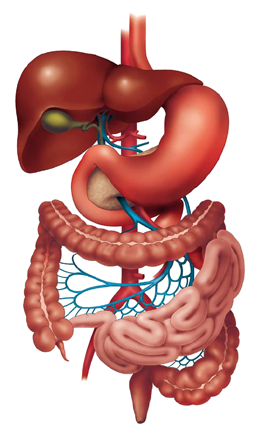
DIGESTIVE SYSTEM (পরিপাকতন্ত্র)
(digestion of food into simpler nutrition, soluble and absorbent)
System Description :
The digestive system is a group of organs working together to convert food into energy and basic nutrients to feed the entire body. Food passes through a long tube inside the body known as the alimentary canal or the gastrointestinal tract (GI tract).
How the Digestive system work?
Food enters the mouth and passes to the anus through the hollow organs of the GI tract. The liver, pancreas, and gallbladder are the solid organs of the digestive system. The digestive system helps the body digest food. Bacteria in the GI tract, also called gut flora or microbiome, help with digestion.
Parts of the GI Tract :
The outermost layer of the gastrointestinal tract consists of several layers of connective tissue. Intraperitoneal parts of the GI tract are covered with serosa. These include most of the stomach, first part of the duodenum, all of the small intestine, caecum and appendix, transverse colon, sigmoid colon and rectum.

Prescriptions domo of the Gastritis System :
C2.1) Gastritis : Gastritis is inflammation of the lining of the stomach. It may occur as a short episode or may be of a long duration. There may be no symptoms but, when symptoms are present, the most common is upper abdominal pain. Other possible symptoms include nausea and vomiting, bloating, loss of appetite and heartburn.
C2.2) Ulcer : An ulcer is a sore on the skin or a mucous membrane, accompanied by the disintegration of tissue. ... They can also be caused due to a lack of mobility, which causes prolonged pressure on the tissues. This stress in the blood circulation is transformed to a skin ulcer, commonly known as bedsores or decubitus ulcers.
C2.3) Chronic dysentery : Usually Shigella or Entamoeba histolytica. Dysentery is a type of gastroenteritis that results in diarrhea with blood. Other symptoms may include fever, abdominal pain, and a feeling of incomplete defecation. It is caused by several types of infections such as bacteria, viruses, parasitic worms, or protozoa.
C2.4) Constipation : Constipation: Infrequent and frequently incomplete bowel movements. Constipation is the opposite of diarrhea and is commonly caused by irritable bowel syndrome (IBS), diverticulosis, and medications. Paradoxically, constipation can also be caused by overuse of laxatives.
C2.5) IBS : Irritable bowel syndrome (IBS) is a common disorder that affects the large intestine. Signs and symptoms include cramping, abdominal pain, bloating, gas, and diarrhea or constipation, or both. IBS is a chronic condition that you'll need to manage long term.
C2.6) Piles : Hemorrhoids, also called piles, are vascular structures in the anal canal. In their normal state, they are cushions that help with stool control. They become a disease when swollen or inflamed;
the unqualified term "hemorrhoid" is often used to refer to the disease.
What is the cause of piles?
A low-fibre diet or inadequate fluid intake can cause constipation, which can contribute to haemorrhoids in two ways: it promotes straining on the toilet and it also aggravates the haemorrhoids by producing hard stools that further irritate the swollen veins.
C2.7) URTI : Upper respiratory tract infection (URI) is a nonspecific term used to describe acute infections involving the nose, paranasal sinuses, pharynx, larynx, trachea, and bronchi. ... Influenza is a systemic illness that involves the upper respiratory tract and should be differentiated from other URIs.

Thank you for your interest !
This page is comming soon

